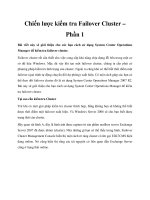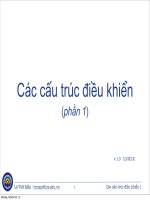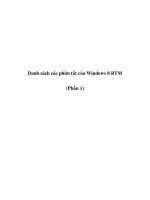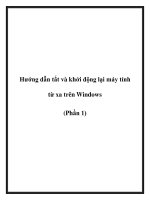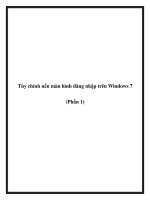iPhone Cool Projects phần 1 potx
Bạn đang xem bản rút gọn của tài liệu. Xem và tải ngay bản đầy đủ của tài liệu tại đây (4.17 MB, 24 trang )
Learn the Coding Secrets of Master
iPhone Designers and Developers
iPhone
Cool Projects
Gary Bennett
|
Wolfgang Ante
|
Mike Ash
|
Benjamin Jackson
Neil Mix
|
Steven Peterson
|
Matthew “Canis” Rosenfeld
DAVE MARK, SERIES EDITOR
GARY BENNETT
WOLFGANG ANTE
MIKE ASH
BENJAMIN JACKSON
NEIL MIX
STEVEN PETERSON
MATTHEW “CANIS” ROSENFELD
iPhone Cool
Projects
iPhone Cool Projects
Copyright © 2009 by Gary Bennett, Wolfgang Ante, Mike Ash, Benjamin Jackson, Neil Mix, Steven Peterson, Matthew
“Canis” Rosenfeld
All rights reserved. No part of this work may be reproduced or transmitted in any form or by any means, electronic
or mechanical, including photocopying, recording, or by any information storage or retrieval system, without the
prior written permission of the copyright owner and the publisher.
ISBN-13 (pbk): 978-1-4302-2357-3
ISBN-13 (electronic): 978-1-4302-2358-0
Printed and bound in the United States of America 9 8 7 6 5 4 3 2 1
Trademarked names may appear in this book. Rather than use a trademark symbol with every occurrence of a
trademarked name, we use the names only in an editorial fashion and to the benefit of the trademark owner, with
no intention of infringement of the trademark.
Lead Editor: Clay Andres
Development Editor: Douglas Pundick
Technical Reviewers: Glenn Cole, Gary Bennett
Editorial Board: Clay Andres, Steve Anglin, Mark Beckner, Ewan Buckingham, Tony Campbell, Gary Cornell,
Jonathan Gennick, Michelle Lowman, Matthew Moodie, Jeffrey Pepper, Frank Pohlmann, Ben Renow-Clarke,
Dominic Shakeshaft, Matt Wade, Tom Welsh
Copy Editor: Heather Lang
Associate Production Director: Kari Brooks-Copony
Production Editor: Laura Esterman
Compositor: Dina Quan
Proofreader: April Eddy
Indexer: BIM Indexing & Proofreading Services
Artist: April Milne
Cover Designer: Kurt Krames
Manufacturing Director: Tom Debolski
Distributed to the book trade worldwide by Springer-Verlag New York, Inc., 233 Spring Street, 6th Floor, New York,
NY 10013. Phone 1-800-SPRINGER, fax 201-348-4505, e-mail , or visit
.
For information on translations, please contact Apress directly at 2855 Telegraph Avenue, Suite 600, Berkeley, CA
94705. Phone 510-549-5930, fax 510-549-5939, e-mail , or visit .
Apress and friends of ED books may be purchased in bulk for academic, corporate, or promotional use. eBook
versions and licenses are also available for most titles. For more information, reference our Special Bulk Sales–eBook
Licensing web page at />The information in this book is distributed on an “as is” basis, without warranty. Although every precaution has
been taken in the preparation of this work, neither the author(s) nor Apress shall have any liability to any person or
entity with respect to any loss or damage caused or alleged to be caused directly or indirectly by the information
contained in this work.
The source code for this book is available to readers at . You will need to answer
questions pertaining to this book in order to successfully download the code.
This book is dedicated to my wife, children, and friends who never stop believing in me. Also, I want to thank
my friend Greg Stanley, who taught me the importance of thinking positive and being humble.
This, I will always be grateful for.
—Gary Bennett
To my grandfather, Bernard Cohn, who handed down my first Apple computer.
—Benjamin Jackson
Neil Mix would like to thank his wife, Sarah, and his son, Henry, for encouraging him to take the time
and energy to build Pandora Radio and contribute to this book. He would also like to thank his
teammates at Pandora for being the best engineering team, period. Without them,
Pandora Radio would not have been possible.
—Neil Mix
For my parents Pam & John: thanks for being my biggest fans.
—Steven Peterson
With love and thanks to Scary
—Matthew “Canis” Rosenfeld
Contents at a Glance
About the Lead Author xi
About the Technical Consultant xiii
Acknowledgments xv
Introduction xvii
WOLFGANG ANTE
CHAPTER 1 Designing a Simple, Frenzic-Style Puzzle Game 3
MIKE ASH
CHAPTER 2 Mike Ash’s Deep Dive Into Peer-to-Peer Networking 29
GARY BENNETT
CHAPTER 3 Doing Several Things at Once: Performance Enhancements
with Threading 57
MATTHEW “CANIS” ROSENFELD
CHAPTER 4 All Fingers and Thumbs: Multitouch Interface Design
and Implementation 81
BENJAMIN JACKSON
CHAPTER 5 Physics, Sprites, and Animation with the cocos2d-iPhone
Framework 107
NEIL MIX
CHAPTER 6 Serious Streaming Audio the Pandora Radio Way 133
STEVEN PETERSON
CHAPTER 7 Going the Routesy Way with Core Location, XML,
and SQLite 157
INDEX 203
Contents
About the Lead Author xi
About the Technical Consultant xiii
Acknowledgments xv
Introduction xvii
WOLFGANG ANTE
CHAPTER 1 Designing a Simple, Frenzic-Style Puzzle Game 3
Creating Frenzic 3
Introducing Formic 5
Exploring the Formic Code 6
Setting Up the Project 8
Coding the Game Object 10
Coding the View Controller 18
Coding the Background View 21
Adding iPhone-Specific Functionality 22
Summary 25
MIKE ASH
CHAPTER 2 Mike Ash’s Deep Dive Into Peer-to-Peer
Networking
29
Planning a Simple Collaborative Game 30
Building the GUI 30
Networking the Game 35
Defining the Networking Goals 35
Designing the Network Code 36
Understanding Endianness 40
Coding the Networking 41
Integrating Networking and the GUI 50
Summary 53
CONTENTSviii
GARY BENNETT
CHAPTER 3 Doing Several Things at Once: Performance
Enhancements with Threading
57
Beginning to Write Threading Applications 59
Knowing When to Thread 59
Understanding Threading Basics 61
Avoiding Threading Pitfalls 63
Writing the Thread the Needle Application 65
Building Our Application 65
Creating a Thread 72
Implementing a Critical Section 76
Stopping Multiple Threads at Once 77
Summary 77
MATTHEW “CANIS” ROSENFELD
CHAPTER 4 All Fingers and Thumbs: Multitouch Interface
Design and Implementation
81
Looking at the iPhone’s Capabilities 82
Designing for Multitouch. . . . . . . . . . . . . . . . . . . . . . . . . . . . . . . . . . . . . .84
Exploring the Multitouch API 87
Handling Events 87
Recognizing Gestures 89
Implementing Multitouch Controls 92
Handling Touches 94
Deciding What Movement Means 97
Applying the Movement 99
Applying Weight and Inertia 100
Tying Up Loose Ends 102
Summary 103
BENJAMIN JACKSON
CHAPTER 5 Physics, Sprites, and Animation with the
cocos2d-iPhone Framework
107
Getting Started with Game Programming 108
Introducing OpenGL ES 109
Introducing cocos2d and Chipmunk 109
CONTENTS ix
Developing Arcade Hockey 109
Tracking the User’s Finger 112
Detecting Collisions 114
Simulating 3D Lighting in 2D Space 118
Creating a Simple Application 119
Setting Up the Xcode Project 119
Setting the Scene 121
Creating the Game Layer 122
Summary 129
NEIL MIX
CHAPTER 6 Serious Streaming Audio the Pandora
Radio Way
133
Choosing to Develop for the iPhone 133
Introducing Pandora Radio’s Technology 134
Grasping the Basics of Audio Development 134
Managing Complexity 136
Outlining Our Sample Application 136
Streaming Audio 137
Keeping Your Code Format Agnostic 138
Using Envelopes and Encoding 138
Designing Our Sample Application 139
Implementing the Player 141
AudioSession 142
AudioRequest 143
AudioFileStream 145
AudioQueue 147
AudioPlayer 147
Ending with a New Journey 148
Falling Behind in a Slow Network 148
Dropped Connections 150
Minimizing Gaps Between Songs 151
Resuming a Song 151
Improving Application Responsiveness 151
Finding Help Resources 152
Testing: Saving the Best for Last 152
Summary 153
CONTENTSx
STEVEN PETERSON
CHAPTER 7 Going the Routesy Way with Core Location,
XML, and SQLite
157
Starting from Scratch 158
Assessing the Application Requirements 158
Creating the Routesy User Interface and Classes 160
Bringing Real-Time Predictions to Routesy 179
Adding Location-Based Information to Routesy 191
Putting the Finishing Touches on Routesy BART 195
Summary 200
INDEX 203
xi
About the Lead Author
Gary Bennett is the lead author on this project. He served for 10 years as a nuclear power
engineer on two different nuclear powered submarines. On shore duty, Gary completed
his Bachelor of Science degree in computer science.
After college, he worked for GTE Data Services and Arizona Public Service converting hun-
dreds of thousands of lines of OS/2 code to Windows NT. Gary then worked for several
technology and health care companies developing Windows NT and Linux applications,
including satellite communications. After that, Gary was chief information officer of a young
health care company that successfully completed an IPO.
In 2007, Gary started his own technology company, xcelMe.com, focusing on Mac and
iPhone development. In 2008, xcelMe.com was hired to develop leading ski and snow report
iPhone applications. Since 2008, Gary has been dedicated to teaching others iPhone devel-
opment. xcelMe.com has developed online iPhone development and marketing courses
affordable to all. Gary has taught hundreds of students iPhone development online through-
out the world. Gary continues to release helpful iPhone development YouTube videos
that benefit the iPhone development community.
In 2009, he worked with EA Sports at their Tiburon studios in Orlando, Florida, where he
launched his third iPhone App, Tee Shot Live. He is currently working for a financial institu-
tion developing an online banking iPhone app.
About the Technical
Consultant
Glenn Cole was the technical consultant on this book. He has been a professional software
developer for nearly three decades, from COBOL and IMAGE on the HP 3000 to Java, Perl,
shell scripts, and Oracle on the HP 9000. He is a 2003 alumnus of the Cocoa Bootcamp at the
Big Nerd Ranch. In his spare time, he enjoys road trips and furthering his technical skills.
Acknowledgments
This book is a compilation of a lot of great work by some really smart authors. They have
focused and contributed their chapters based on areas of their expertise. You get to
benefit from the years of their expertise; enjoy it!
I am so impressed by the fine people at Apress. I believe their books are the finest on the
market. Additionally, they are great to work with. I have made many friends.
I would like to thank “Admiral” Clay Andres whose vision and ability to put together a tal-
ented team made this great book possible. He is actually not an Admiral, but should be. Our
copy editor, Heather Lang, and development editor, Douglas Pundick, were so very helpful
in making sure the quality of the book was what you would want. Special thanks to Laura
Esterman and Dina Quan for managing the book production process when it needed it the
most.
Lastly I would like to thank Michelle Lowman for connecting Clay Andres and myself and
giving me the privilege to be part of this great project.
Gary Bennett
I would like to thank Ivan Neto, Benjamin Maslen, and Rafael Cruz for their hard work on
Arcade Hockey, and my parents Lillian Cohn and Larry Jackson for their nonstop love and
support.
Benjamin Jackson
Introduction
You are going to love this book! I know I do, and I had to read every word of it and check
every line of code, twice!!
If you’re like me, you’ve registered as an iPhone developer with Apple, read some documen-
tation, and sought help in taking the next bold step. Perhaps you’ve picked up “Beginning
iPhone Development,” dutifully working through all of the projects, and you understood
most of it. If not, I heartily recommend it. The book is great because it gently guides you
through many of the technologies that make up an iPhone application. Make no mistake;
the book covers a lot of ground. But the projects are kept relatively simple to keep the les-
sons focused.
First step taken, now boldly onward into the fray!
This book picks up where “Beginning iPhone Development” leaves off. The projects herein
were developed specifically for this book, but these are no lightweight applications. Some
projects are based on shipping products, showing how various technologies are integrated
into a cohesive application. Other projects cover difficult topics and thus are more focused.
The projects illustrate advanced topics such as game timers, XML parsing, streaming audio,
multithreading, recognizing advanced gestures, and even designing your own network
protocol using UDP (and why you would want to do this). You’ll be discussing mutexes, race
conditions, sockets, packets, and endianness in no time!
Those who want to develop immersive games have long heard that using a game engine
is important, but getting started has been a challenge. Here at last is a game that is built
around the open source cocos2d game engine, explained in great detail.
All the chapters represent the personal experience of successful developers; they are written
by the developers whose skills we admire and respect.
In short, your next steps are clearly laid out for you.
Who this book is for
This book is for all iPhone and iPod touch developers who want to know more so that they
can tackle more difficult programming tasks on their way to creating the next great app. Per-
haps you have completed an introductory book such as “Beginning iPhone Development”
INTRODUCTIONxviii
by Dave Mark and Jeff LaMarche, or possibly you have already completed a simple app and
you’re ready for the next step on your journey.
It also helps to be comfortable with Cocoa Touch, basic Xcode tools, and Objective-C. You
can pick up extra help from “Learn C on the Mac” by Dave Mark, “Expert C Programming”
by Peter van der Linden, and “Learn Objective-C for the Mac” by Mark Dalrymple and Scott
Knaster.
Mostly, this book is for anyone who wants to write better apps for iPhone and iPod touch
and is willing to put in a little time to learn from some of those who have already succeeded
at it.
What’s in the book
We open with Wolfgang Ante, the developer behind the Frenzic puzzle game, showing how
the game was developed and guiding us through the process of creating a similar game
called Formic. Timers, animation, and intelligence are used to make the play engaging. If you
have been wanting to write a game but have had difficulty getting started, this chapter will
provide the guidance and inspiration you need!
Chapter 2 finds Rogue Amoeba’s Mike Ash explaining how to design a network protocol
using UDP, and demonstrating its use in a peer-to-peer application. This topic is not for the
faint of heart, but Mike explains it in a way that makes sense to us mere mortals. I had never
seen this topic covered before, so I’m thrilled to see it here.
Next up with Chapter 3 is Gary Bennett covering the daunting but important task of multi-
threading. The CPUs in the iPhone and iPod touch won’t be mistaken for those of the Mac
Pro, but they pack enough power that frequently they are waiting for something to do.
Multithreading can be used to keep the user interface responsive while working on other
tasks in the background. Gary demonstrates how to do this, and highlights traps to avoid
along the way.
In Chapter 4, Canis Lupus (a.k.a. Matthew Rosenfeld) describes the development of the
Keynote-controlling application Stage Hand, how the user interface evolved, and the lessons
learned from that experience. This knowledge is then demonstrated in a project showing
how to recognize many complex gestures at once, including flicking (with inertia!) and rotat-
ing an object. Remote controls should all be this handy.
Benjamin Jackson introduces us to two open source libraries in Chapter 5: cocos2d for 2D
gaming, and Chipmunk for rigid body physics (think “collisions”). He describes the develop-
ment of Arcade Hockey, an air hockey game, and explains some of the code used for this.
Benjamin then guides us through the creation of a miniature golf game. It’s definitely helpful
to have such clear guidance through these very murky waters.
INTRODUCTION xix
Processing streaming audio seems like yet another black art. Luckily for us, Neil Mix of
Pandora Radio reveals the science behind the magic in Chapter 6. How do you debug what
you can’t see? Neil guides us through the toughest challenges, sharing his experience of
what works and what to watch for. Audio is hard; I’m thankful to have such a difficult topic
explained so clearly. Some of the techniques shown can be used for non-audio applications
as well.
The book concludes with Steven Peterson demonstrating a more prosaic integration of
iPhone technologies. He weaves Core Location, networking, XML, XPath, and SQLite into a
solid and very useful application. Games are great fun, but this is the type of application that
makes the device so compelling for the non-gamer. You’ve seen some of the pieces before;
now you’ll see how to put them all together.
Software development can be hard. Introductory books lay the foundation, but it can be
challenging to understand where to go next. This book shows how to integrate the pieces
into a complete application. In addition, many of the topics covered here are notoriously dif-
ficult. You'll want to read the chapters more than once, then keep them handy for reference.
Working through the chapters was great fun, and I learned a tremendous amount. I’m sure
you will as well!
Glenn Cole
Wolfgang Ante
Company: ARTIS Software
Location: Vienna, Austria
Former life as a developer: Macintosh Software Developer since 1994.
Received the Macworld Editor’s Choice Award (1999) and MacUser
Award 2004, both for Best Graphics Utility.
Life as an iPhone Developer: Built the Frenzic puzzle game with Xcode
and Interface Builder
What’s in this chapter: After providing some insight into the develop-
ment of Frenzic, this chapter discusses a similar game called Formic
that shows the basic techniques behind the game logic and animations
of a puzzle game.
Key technologies
N
Using UIView animations for visual feedback
N
Using NSTimers to keep the game running
N
Using NSUserDefaults to save and restore games
